Philips OLED+935 (48OLED935) review: OLED and Dolby Atmos in one unbeatable value package
The Philips OLED+935 delivers an outstanding TV and soundbar combo for movies, but isn't ideal for gaming

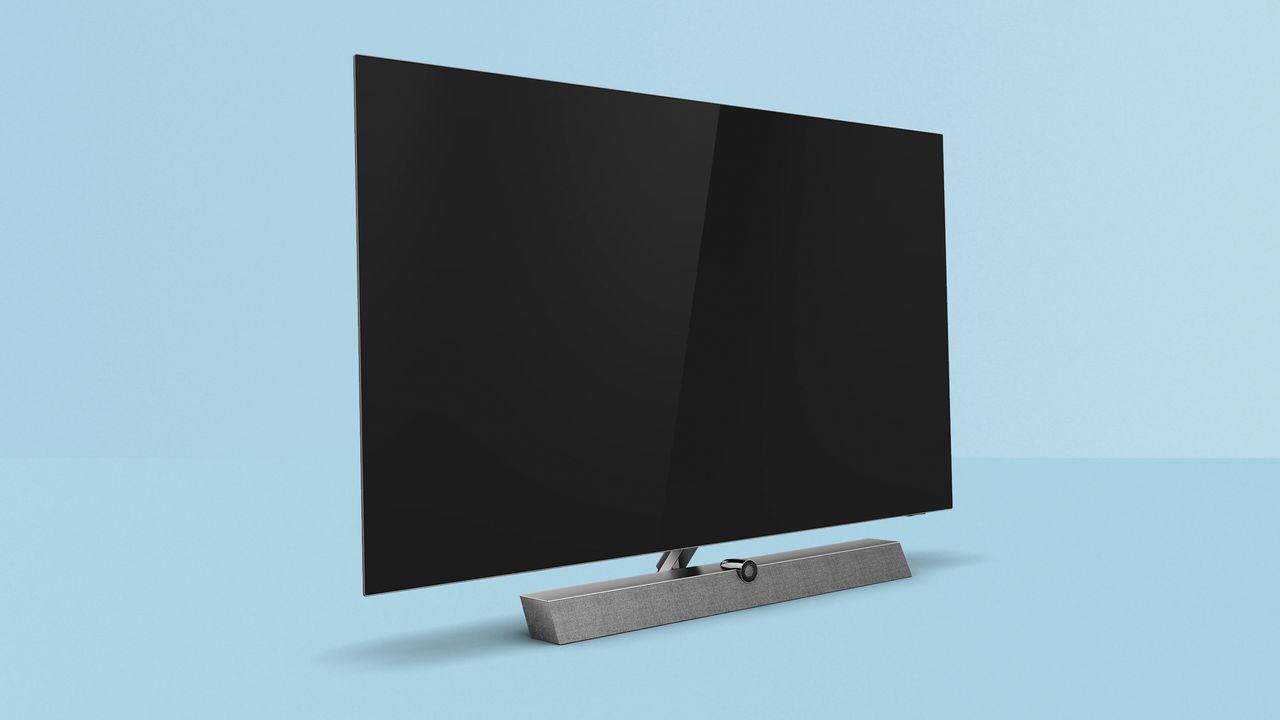
The Philips OLED+935 is an impressive package. If you want an OLED TV with powerful integrated audio and exceptional picture quality, it's perfect. Those looking for a next-gen console companion will have to go elsewhere, though
-
+
Outstanding picture quality
-
+
Equally outstanding sound quality
-
+
Elegant design
-
+
Great Ambilight feature
- +
-
-
No friend of next-gen games consoles
-
-
Android TV is a divisive interface
- -
Why you can trust T3

Welcome to T3's Philips OLED+935 review. We tested out the 48-inch version which is the smallest in Philips' sound-focussed OLED range and a pocket rocket that launched itself into our list of the best TVs.
High-quality OLED TVs were, until very recently, reserved for 55-inch screens and above, meaning those who couldn't accommodate them were forced to opt for less impressive specs. At long last, those wishes of high-quality, smaller TVs were granted and 2020 finally saw a few TV manufacturers launch their first 48-inch OLED sets.
But there's a lot more to this than just being able to buy a smaller version of a TV: the OLED+935 has piled tons of features into this compact, good-looking OLED television. Now, it covers all realistic audio/visual bases – and then one or two others, just for good measure.
An unexpected feature on the Philips OLED+935 is the built-in Dolby Atmos sound system from Bowers and Wilkins, which gives you the immersive audio experience you would usually need a separate soundbar for.
It makes the OLED+935 slightly more expensive as a TV than its OLED peers, but it's cheaper than buying both a TV and a soundbar, so we think it's pretty good value overall.
One thing to note for our US readers is that this TV is only available in the UK and Europe, sadly.
Philips OLED+935 review: Price & features
The OLED+935 is available in three screen sizes: the 48-inch model we’re testing here (£1,799), a 55-inch variant (£1,999) and a 65-inch version (£2,799).
Anyone who’s currently shopping around for a nice new OLED TV will know these are not the sort of aggressive prices Philips has mostly been pursuing with its OLED televisions until now – it's a bit more than the Philips OLED805, and a lot more than the Philips OLED745. But the extensive list of features crammed into the OLED+935 goes some way to explaining how prices have ended up at this level.
First and foremost, of course, these are 4K HDR TVs. Philips, unlike the majority of its nominal rivals, handles each and every HDR standard – both HDR10+ and Dolby Vision dynamic metadata HDR are catered for. That’s more than LG, Samsung or Sony can claim.
In terms of inputs and outputs, the OLED+935 has plenty going on. There are four HDMI sockets, a couple of USBs, an Ethernet input, a CI card slot and binding posts for both satellite and terrestrial tuners. In terms of outputs, there’s digital optical, a 3.5mm headphone socket and a pre-out for a subwoofer. Where wireless connections are concerned, there’s dual-band Wi-Fi along with Bluetooth 4.2 connectivity.
There are definite pros and cons when it comes to the HDMI sockets. On the ‘pro’ side, all four are ARC-enabled, all four are HDCP 2.3-compliant and all four can handle the Auto Low Latency Mode that’s one of the defining features of the upcoming next-generation games consoles. We like to see ports that are all identical – takes away the worry of working out whether you have the right device connected to the right socket.
As regards the ‘cons’, though, none of the HDMI sockets is close to HDMI 2.1 specification, which means no 4K at 120Hz and no Variable Refresh Rate, which are the bigger two new feature supported by the PS5 and Xbox Series X. If you want your new TV to make the most of your next games console, this almost certainly isn’t the television for you and you'll want to check T3's best gaming TVs.
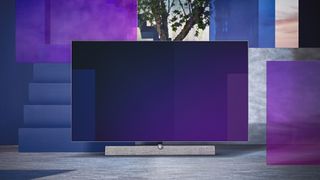
The lack of eARC compatibility on any of the HDMI sockets might seem a bit odd at first, too. But there’s really no need for it, because the OLED+935 is the latest result of the ongoing collaboration between Philips and storied loudspeaker savant Bowers & Wilkins. The OLED+935 incorporates a chunky off-board speaker array (beautifully finished in the obligatory Kvadrat acoustic cloth) which also doubles as a stand if you’re not wall-mounting your new TV.
Three 19mm titanium-dome tweeters (one enclosed in B&W’s equally obligatory ‘tweeter on top’ metal enclosure) and four 50mm midrange drivers are arranged in a ‘left/centre/right’ forward-firing configuration, while two more 50mm midrange drivers contribute Dolby Atmos ‘elevation’ presence by firing upwards from the top of the bar. For good measure, there’s a 100mm x 65mm ‘racetrack’-style subwoofer firing from a ported enclosure at the rear of the enclosure. This 3.1.2 Dolby Atmos-esque arrangement is driven by a total of 70 watts of power.
And, because this is a Philips TV, it also incorporates one of the very, very few unique selling points in all of Television Land: Ambilight. For the uninitiated, Ambilight is an arrangement of LEDs on the rear panel of the TV, designed to illuminate the surface behind the screen with a coloured glow that mimics the colour of the on-screen action. It sounds gimmicky, but (as anyone who’s seen it in action knows) it actually works a treat, delivering a more immersive experience and making the screen seem considerably bigger than it actually is. And because of the way the screen connects to its soundbar, here Ambilight features on all four sides of the rear panel.
Inside, Philips has deployed its most recent and powerful picture processing, the fourth generation of its P5 engine. In the OLED+935 there’s a second processing chip, running AI functionality in an effort to offer better-balanced images and using machine learning to deliver more convincing upscaling. This dual-chip arrangement also allows Philips to offer some protection against the dreaded ‘screen burn’ – the OLED+935 is constantly hunting for static on-screen images in order to dim them and prevent image retention.
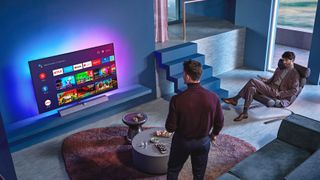
Philips OLED+935 review: Picture quality
As is traditional with Philips, there are any number of set-up menus and submenus to be investigated, and settings to be finessed, before your OLED+935 can really be deemed ready to play. But, as is traditional with Philips, patience and perseverance bring unarguable rewards.
Thanks to the AI aspect of its processing, the OLED+935 is able to identify incoming images and respond to them with extraordinary speed and efficiency, and the resulting images are among the most convincing, most lifelike and most enthralling around.
HDR-assisted images, particularly in terms of colour, are deeply impressive. The OLED+935 is capable of both bold saturation of tone and remarkable subtlety, sometimes in the same image. Primary colours pop from the screen assertively, but the nuances of skin-tone or shadow-detail aren’t overlooked or underplayed. It’s no mean feat to deliver a colour palette that’s almost aggressive in its vivacity yet endlessly subtle at the same time, but that’s exactly what the Philips does.
Top-of-the-shop 4K HDR pictures are sharp, which has always been how Philips likes them, but here they’re not as overtly edgy as has been the case with Philips TVs in the past. There’s still a stack of definition on display, and edges are drawn unequivocally, but that almost ‘etched’ quality of some previous Philips screens is absent here. The OLED+945 is a more natural and convincing watch as a result.
Detail levels add to the immersive nature of the Philips’ images – even the finest details of texture or pattern can’t evade it, and complicated patterns are gripped firmly. The sort of tight plaid patterns that might have provoked some shimmer or uncertainty in last year’s Philips OLEDs can’t faze the OLED+935.
And despite this being far from the brightest OLED TV around (though it's in a similar ballpark to the likes of the LG CX – just not the Panasonic HZ2000) the cleanliness of the white tones balance against the inkily deep black shades to create expansive contrasts.
Motion processing is probably the least assured of the OLED+935’s 4K picture performance – which says more about how right it gets everything else rather than being an overt criticism. No, you’re not about to hit on the perfect balance of smooth motion and natural, unprocessed-looking images without working at it. But invest just a little time and effort, and judder-free, artefact-free motion can be achieved. Eventually.
Stepping down in the quality of incoming content results in the inevitable drop-off in overall quality, but the OLED+935 is never less than entirely watchable. With 1080p content there’s still an epic colour gamut, low noise and crisply defined edges, it’s just that they’re joined by a little motion hesitancy and, in extremis, crushing of black tones.
It remains a fully competitive TV as far as picture quality is concerned, though. Even antique daytime-TV 4:3 SDR content is made the best of, although ‘best’ in this instance translates as ‘soft’ and ‘lacking definition’. But then, really, what can you expect? The OLED+935 isn’t the first TV to make 1980s programming look rotten, and it won’t be the last.
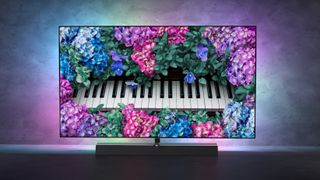
Philips OLED+935 review: Sound quality
Philips isn’t the only TV brand to have tied in a venerable hi-fi name to assist in the sound of its premium televisions – Panasonic has done something similar with its Technics brand. But, and we don’t say this lightly, no other integrated TV audio system is anything like as effective or convincing as the Bowers & Wilkins arrangement the OLED+935 is toting.
In every respect – scale, dynamism, focus, you name it – the Philips sounds so much better than its nominal competitors it’s almost comical. Oh, obviously you’re paying a premium for all this Bowers & Wilkins expertise, but less than you’d pay for an equally capable off-board audio system, and any third-party system isn’t going to integrate as seamlessly with your TV as this one.
And besides, even a very capable £500 stand-alone soundbar will struggle to match this level of responsiveness, this level of tonal fidelity or this ability with effects placement. The sound that comes from this array is balanced, tonally impeccable and much, much wider and taller than the physical confines of the enclosure. It doesn’t harden at big volumes, bass doesn’t disappear at lower volumes, and dialogue is never subsumed by other effects.
It’s safe to say that Dolby Atmos soundtracks don’t have that ‘directly overhead’ effect that a full-on home cinema system can deliver, but then this isn’t a full-on home cinema system. It’s a discreet, well made and beautifully integrated TV sound system – and judged on those terms it’s comfortably the best of its type currently available.
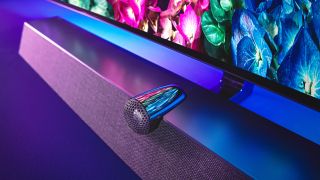
Philips OLED+935 review: Design & usability
Everyone knows OLED TVs are gloriously slim right until the part where they store all their electronics hardware, and so an OLED TV can really only be as slim as its deepest part. Philips, sensibly, has decided against pursuing ‘as much slimness as possible’ in favour of giving its Ambilight feature as much room to operate as is necessary. And given that the OLED+935 is only 47mm deep at its chubbiest point, it’s hardly a bloater in any case.
Viewed from the front, the OLED+935 is neat and tidy, with a vanishingly slim bezel surrounding a great big expanse of screen. The chromed metal union between the screen and the Bowers & Wilkins soundbar is reassuringly hefty, and the soundbar itself is flawlessly built and finished. The overall impression is that of a premium product – and that’s before the Philips is even plugged into the mains.
Control is mainly via a slim, relatively elegant and nicely finished remote control. It may well be the first remote control T3 has encountered that’s finished on its reverse in Muirhead Leather, although it’s sadly not the first to retain a greasy fingerprint with real tenacity. It’s sensibly laid out, though, doesn’t feature too many buttons and none of them are particularly small.
It's used to navigate both Philips’ typically labyrinthine set-up menus and the Android 9.0 smart TV interface. As per usual with Android TV, this interface is labouring under the misapprehension that it’s the most important thing about your whole ‘new TV’ experience, hogging the entire screen when it’s activated and being tardy in its responses.
It’s quite easily customised, though, and – apart from the lack of Apple TV – is very well stocked with useful apps of all kinds. Freeview Play provides access to every UK broadcaster’s catch-up services.
There’s a mic on the remote control, from where it’s possible to use Google Assistant voice control to navigate the OLED+935. The mic proves sharp-eared and the TV responsive, although it seems impossible to prevent Google Assistant yelling its responses to your commands.
Philips OLED+935 review: Verdict
In the end it’s quite simple. As a combination of picture and sound quality at this price, the Philips OLED+935 cannot currently be beaten. That's particularly true of the 48-inch version we tested, but applies to the other sizes also.
If you want to upgrade both your visuals and audio to use the latest cutting-edge tech in movies without any hassle around choosing and connecting separate boxes, Philips has made it both easier and cheaper here.
The OLED+935 isn’t without its quirks (mostly of set-up and navigation), the choice of Android as an operating system remains contentious, and the lack of next-gen games console support is as mystifying as it is disappointing.
But for film and TV lovers who aren't bothered about next-gen gaming, and want a simple, beautiful premium TV and speaker experience, this is simply a fantastic choice.
Philips OLED+935 review: Also consider
When it comes to elite picture quality, the Panasonic HZ2000 is the cream of the OLED crop. It only comes in 55-inch or 65-inch size, but has a brighter panel than any other OLED, giving the best HDR performance on the market. It has a Technics soundbar underneath the screen, and two upfiring drivers for Dolby Atmos, but the overall audio effect isn't as good as what the OLED+935 achieves. Our full Panasonic HZ2000 review explains why it's so uniquely capable for visual quality.
The LG CX is the OLED TV to beat when it comes to a combination of price, picture quality and technical features. It's available in a 48-inch model, plus 55-inch, 65-inch and 77-inch. Image quality is on a par with Philips, but the LG CX is cheaper and and includes every next-gen gaming feature, so is the ideal TV for PS5 or Xbox Series X, while also being excellent at movies and TV. However, the sound is distinctly average, so we'd recommend adding one of the best soundbars, which takes the price back above the Philips! Read our full LG CX review if you're wondering if this TV is a better choice for you.
- The best 32-inch TVs – perfect for bedrooms and offices
- The best 43-inch TVs – great entry-level 4K sets
- The best 48- to 50-inch TVs – beautiful mid-size 4K TV sets
- The best 55-inch TVs – premium TVs that still fit most living rooms
- The best 65-inch TVs – beautiful big-screen TVs
- The best 75-inch TVs – giant 4K and 8K TVs packed with features
Sign up to the T3 newsletter for smarter living straight to your inbox
Get all the latest news, reviews, deals and buying guides on gorgeous tech, home and active products from the T3 experts
Simon Lucas is a freelance technology journalist and consultant, with particular emphasis on the audio/video aspects of home entertainment. Before embracing the carefree life of the freelancer, he was editor of What Hi-Fi? magazine and website – since then, he's written for titles such as Wired, Metro, the Guardian and Stuff, among many others. Should he find himself with a spare moment, Simon likes nothing more than publishing and then quickly deleting tweets about the state of the nation (in general), the state of Aston Villa (in particular) and the state of his partner's cat.
-
 The new Tesla Model Y is here but you can’t have one (yet)
The new Tesla Model Y is here but you can’t have one (yet)With a facelift giving Cybertruck vibes, this new Tesla is only available in China and Australia – at least for now
By Alistair Charlton Published
-
 Full Nintendo Switch 2 announcement could be just days away
Full Nintendo Switch 2 announcement could be just days awayReliable industry expert claims the Switch 2 will be unveiled later this week.
By Rik Henderson Published
-
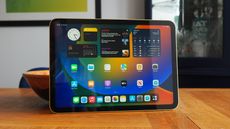 Apple's affordable iPad set for major speed boost and Apple Intelligence
Apple's affordable iPad set for major speed boost and Apple IntelligenceIt's exciting times ahead for the entry-level tablet
By Britta O'Boyle Published